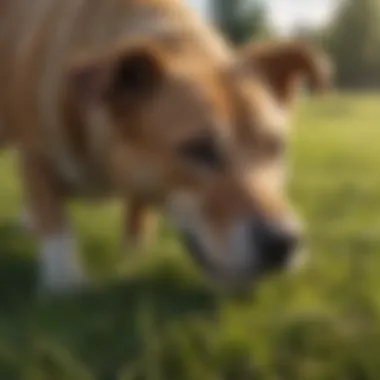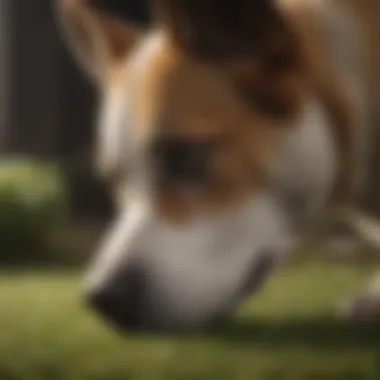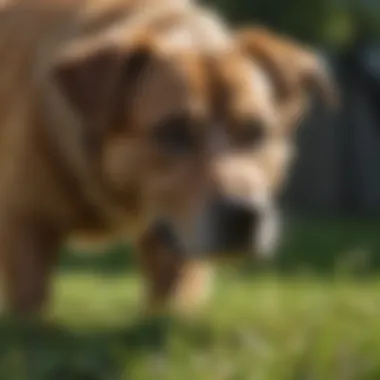Understanding Dog Behavior: Gagging and Grass Eating


Intro
Dog behavior is a fascinating field intertwining instinct, evolution, and companionship. Amongst the myriad of actions displayed by canines, two behaviors often spark curiosity and concern among dog owners are gagging and grass eating. These actions, although common, can leave pet owners scratching their heads, pondering whether they should worry or just let it slide. Understanding why your furry friend engages in these behaviors requires a dive into their instincts, health implications, and the role that grass plays in their lives.
In this article, we'll explore these canine peculiarities more deeply, aiming to shed light on what drives dogs to gag and consume grass, the possible meanings behind these behaviors, and how pet owners can respond effectively. By delving into research, personal observations, and expert insights, we'll aim to present a nuanced approach to understanding our four-legged friends better.
Prologue to Dogs and Their Unique Behaviors
Dogs are more than just pets; they are companions that bring joy and complexity to our lives. Understanding their behaviors is crucial for building a healthy relationship with these animals. This section aims to delve into the unique behaviors that dogs exhibit, focusing specifically on gagging and grass consumption. Grasping these behaviors involves looking at various aspects of canine instincts and health, highlighting both the physical and psychological factors at play.
Background on Canine Behavior
Canine behavior is a rich tapestry woven from instinct, training, and environment. From the moment a puppy is born, it is equipped with innate behaviors tied to survival and social interaction. A puppy instinctively suckles for nourishment, and as they grow, their interests expand to include exploration and play. These actions are not just cute quirks; they offer significant insight into their evolutionary background. Modern dogs carry forward many traits from their ancestors, who had to hunt, forage, and communicate effectively to survive.
Moreover, the environment in which a dog lives can greatly influence its behavior. Dogs that grow in a stimulating setting filled with experiences tend to develop different behavioral patterns compared to those raised in isolation. This evolution of habits continues throughout a dog's life, shaped further by its interactions with humans and other animals. For example, a dog that frequently sees people might become more social, while one that often spends time alone might display anxiety around strangers.
Understanding this background helps owners decipher their dog's actions better, especially when peculiar behaviors arise, such as gagging or munching on grass, both often associated with curiosity or discomfort.
Significance of Understanding Gagging and Grass Eating
Grasping why dogs engage in gagging and eating grass is essential not only for managing potential health risks but also for ensuring overall canine well-being. Both behaviors can stem from simple curiosity or sometimes point to underlying health concerns. For instance, gagging isn't always a sign of distress; it can result from harmless issues like throat irritation from a stuck object or food that's simply gone afoul in their stomach.
On the other hand, grass consumption can evoke a mix of reactions from dog owners. Some might dismiss it as an odd habit, while others worry it indicates an upset stomach. However, research shows that many dogs who eat grass do not subsequently vomit, suggesting that this behavior can merely be instinct-driven—something inherited from wild ancestors that used herbaceous foliage for digestive aid.
To put it simply, understanding these behaviors can lead to better quality of life for dogs and more peace of mind for their owners. Knowledge about gagging and grass consumption not only enlightens pet owners but also opens up discussions regarding their pet’s diet and environmental factors. This foundational understanding of dog behavior enables owners to make informed choices, ensuring a healthy and happy companion.
The Instinctive Nature of Dogs
The behavior of dogs emerges from a complex interplay of genetics, environment, and instinct. Understanding the instinctive nature of dogs provides crucial insights into why our furry companions engage in certain behaviors, including gagging and grass consumption. This section delves into the primal instincts that shape canine actions, revealing why these behaviors are not mere quirks but rather rooted in their evolutionary past and survival strategies. By recognizing these instincts, owners can foster better communication with their pets and manage behaviors effectively.
The Evolutionary Perspective
The evolutionary history of dogs stretches back thousands of years. Originating from wolves, they have adapted over time through the process of domestication. This has influenced not only their physical characteristics but also their behavior. Essentially, many instincts that govern present-day dogs can be traced back to their wild ancestors, who relied on specific behaviors to thrive in the natural world. For example:
- Hunting Practices: Early dogs needed to hunt for food. While modern pets are usually fed by their owners, some instincts remain intact, and behaviors like gagging might mirror a thrifty ancestor's method for expelling indigestible remnants or potential toxins.
- Herbivorous Tendency: There’s a line of thought suggesting that early canines included some plant matter in their diets, implying that the urge to consume grass could come from these ancestral habits. It’s a nod to survival, as eating certain plants might have helped in self-medication or alleviating gastrointestinal upset.
Understanding this historical context can clarify why dogs might eat grass though they aren’t strictly herbivores. In many cases, it’s an ingrained behavior shaped by survival needs.
"The behavior of dogs is a mirror reflecting their ancestral instincts, built through generations of survival tactics."
Instincts and Foraging Behavior
Dogs are inherently curious creatures, driven by instincts that propel their urge to explore and forage. This foraging behavior is not just about finding food; it’s a multifaceted survival skill honed over time. Various instincts can explain why a dog might engage in specific actions, such as learning through observation or experimenting with different types of food, including grass. Here are some notable instincts influencing foraging behavior:
- Scavenging: Many domestic dogs exhibit scavenging as a primary feeding strategy. This instinct, a remnant of their ancestor's behavior, may lead dogs to try and consume anything they find, including plants, as a means to satisfy hunger or curiosity.
- Taste and Texture Preference: Dogs, like humans, have individual preferences for tastes and textures. Grass, particularly if fresh and tender, might provide a sensory experience that’s appealing. While not a common food choice, the texture may also help dogs feel satisfied.
- Instinctive Response to Illness: Some dogs will instinctively consume grass when they feel unwell. This behavior reflects a natural response, as stomach irritation might trigger this innate urge. Consuming grass could be a way for them to induce vomiting or soothe their stomachs when they have gastritis or other digestive issues.
Why Dogs Gag: A Behavioral Analysis
Gagging in dogs is a phenomenon that often puzzles pet owners. By delving into the reasons behind this behavior, we can gain a deeper understanding of our canine companions. Recognizing why dogs gag can help owners respond effectively and ensure their pets’ health and safety. Behavioral analysis here serves to bridge the gap between instinctual actions and health-related concerns, which are significant considerations for any responsible dog owner.
Understanding Gagging in Dogs
Understanding gagging in dogs goes beyond mere observation. It encompasses recognizing the signs that lead up to the event and what it reveals about the dog's physical state and environmental interactions. Gagging can be distressing not just for the dog but for the owner as well. One key element to remember is that gagging is often the body’s way of clearing irritants or blockages from the throat. Sometimes, this behavior can manifest quite dramatically, leading to understandable concern among dog owners. However, it's crucial to evaluate the context - is the dog simply trying to dislodge something, or is there a deeper health concern at play?
It’s not just about the act of gagging itself but how and when it occurs. Patterns and triggers in the dog’s routine and environment can be indicative of a need for intervention or change. An owner’s awareness of these signs can make all the difference. Understanding the dynamics of gagging allows owners to take proactive measures to protect their dogs from potential dangers.
Common Causes of Gagging
Gagging in dogs can be triggered by several factors. Understanding the common causes can help demystify the phenomenon and inform the owner’s response to their pet’s behavior. Below are the most prevalent causes, each with its unique implications:
Foreign Objects
Foreign objects that dogs might ingest can lead to gagging. Dogs are naturally curious and may consume items that are not food, which could lodge in their throat or esophagus. This particular aspect highlights a dog's instinct to explore and chew things, ranging from toys, bones, or even household items. The presence of a foreign object is a red flag in understanding the behavior of gagging.
- Key Characteristic: Foreign objects are often non-digestible and pose a choking hazard.
- Benefit: Being aware of this cause can aid in prompt action if a dog shows signs of distress.
- Unique Feature: While some dogs may experiment with what they can chew, others might just swallow without clear indications of caution.
- Advantages/Disadvantages: Acting swiftly if a foreign object is suspected can prevent serious injury but handling dogs in distress requires care to avoid further panic.
Digestive Issues
Digestive issues can also manifest as gagging. This might arise from an upset stomach or underlying gastrointestinal problems. The relationship between a dog’s diet and their gag reflex is critical. If a dog's diet lacks balance or contains allergens, they might respond by gagging.
- Key Characteristic: Dogs might show other signs of discomfort, like pacing or whining, alongside gagging, which can be attributed to digestive distress.
- Benefit: Recognizing this connection can be beneficial for owners interested in improving their dog’s nutrition.
- Unique Feature: Often connected with dietary changes or exposure to new foods, this cause emphasizes the dog's sensitivity to changes.
- Advantages/Disadvantages: Understanding the link between diet and gagging enables owners to modify feeding practices, but it can also lead to confusion about food choices.
Normal Reactions


Lastly, normal reactions can sometimes lead to gagging. This includes typical behaviors like gulping too quickly or certain vocalizations that can mimic gagging. Dogs might also gag when they’re excited or anxious, as a natural reaction to heightened emotional states.
- Key Characteristic: This aspect illustrates that not all gagging is serious; it can be part of a dog’s expressive nature.
- Benefit: This recognition provides reassurance to owners.
- Unique Feature: A dog's personality can greatly influence their gagging behavior; some breeds may be more prone to this than others.
- Advantages/Disadvantages: Understanding that these reactions often stem from normal behavior can dilute an owner’s immediate concern, but it may also lead to overlooking genuine health issues.
"Awareness and understanding of why your dog might gag can turn panic into proactive care."
In summary, comprehending the many causes of gagging deepens the insights into canine behavior, fostering a healthier relationship between dogs and their owners.
Grass Consumption: A Common Canine Behavior
Grass consumption among dogs is a peculiar but widely observed behavior that requires consideration. It’s not merely an act of appetite but a reflection of various factors influencing canine life. Understanding why dogs munch on grass helps pet owners make informed decisions about their pets’ health and well-being. This article aims to dissect the reasons behind this seemingly odd behavior and address safety concerns related to it.
Reasons for Eating Grass
Nutritional Deficiencies
Nutritional deficiencies could play a notable role in why some dogs feast on grass. When dogs lack certain vitamins or minerals, they sometimes seek out alternative sources to compensate for what’s missing in their regular diet. Grass can provide a unique source of fiber, and in some cases, even trace elements that the dog might be lacking.
Key Characteristics: Nutritional deficiencies arise from imbalanced diets or low-quality dog food. Understanding this aspect emphasizes the importance of providing a complete and balanced diet tailored to a dog's needs.
Unique Feature: The grass may serve as a temporary remedy, but it is not a substitute for essential nutrients.
Advantages/Disadvantages: While a dog nibbling on grass might signal a deficiency, excessive consumption or relying on grass for nutrients is not advisable and might lead to digestive troubles or other health concerns.
Stomach Irritation
Another significant reason dogs engage in grass eating is stomach irritation. If a dog’s stomach feels off, it might instinctively turn to grass, hoping it will induce vomiting. This process could help alleviate discomfort when it feels bloated or nauseous. Interestingly, many dog owners have reported this behavior following an episode of dietary indiscretion, such as eating too many treats or scavenging something inappropriate from the trash.
Key Characteristics: Stomach irritation typically exhibits itself through a dog’s behavioral changes, like vomiting, lethargy, or unusual gurgling noises. Recognizing this can help owners identify the issue quickly.
Unique Feature: The act of consuming grass to seek relief is a tangible example of instinctive behavior rooted in natural tendencies.
Advantages/Disadvantages: While eating grass may temporarily relieve symptoms, it doesn't address underlying issues, making it essential for owners to observe their dogs and consult a veterinarian if symptoms persist.
Instinctual Behavior
The act of eating grass is also believed to be deeply rooted in instinctual behavior. Dogs, being descendants of wild canines, could have evolutionary tendencies that encourage such behavior. Wild ancestors might have consumed grass as part of their diet or as a method to purge their systems of parasites or other unwanted materials. This preserves the idea that certain behaviors, even ones that appear odd today, have historical relevance.
Key Characteristics: Instinctual behavior often reflects survival strategies that align closely with an animal’s environment.
Unique Feature: This instinct is less about nutritional need and more about behaving according to ingrained survival instincts.
Advantages/Disadvantages: Recognizing that grass consumption may stem from these instincts provides reassurance to pet owners. However, it does highlight the importance of monitoring to ensure that these behaviors do not lead to unhealthy eating habits.
Is Grass Safe for Dogs?
While dogs munching on grass may seem harmless, it’s vital to assess the safety of such actions.
Potential Risks
Not all grass is safe; some might be treated with pesticides or herbicides that can harm dogs. Dogs may also consume wild grasses containing sharp blades or toxins that can lead to gastrointestinal upset or worse. Being aware of the risks helps protect your furry companion.
Key Characteristics: Understanding which grasses are safe and which are not is crucial for responsible pet ownership.
Unique Features: Homeowners should monitor their dogs and be cautious about where they roam, particularly in areas that may use chemicals.
Advantages/Disadvantages: The realization that not all grass is equal reinforces the responsibility pet owners carry. It encourages a more proactive approach to pet health and outdoor activities.
Safe vs. Toxic Grasses
Determining which grasses are safe and which ones can be harmful is vital in understanding grass consumption. Certain grass types like Bermuda and Kentucky Bluegrass are generally safe for dogs, while others, such as fescue or ryegrass, could present health hazards. Familiarity with these groups can help guide pet owners in selecting safe environments for their dogs to roam freely.
Key Characteristics: Knowledge of botanical varieties allows dog owners to create secure spaces for their pets.
Unique Feature: Having identified safe grasses not only benefits health but also enriches a dog's interactive outdoor experience, allowing for more natural behaviors to be displayed in a safe manner.
Advantages/Disadvantages: Awareness of grass types encourages responsible pet ownership and clear decision-making, while ignorance could lead to potential health issues.
In the end, while the sight of dogs nibbling on grass can be amusing, it serves as a reminder of our canine companions’ complex behaviors. Through understanding these instincts, pet owners can create a healthier, safer environment for their dogs.
Owner Observations: What Should You Look For?
Understanding the behavior of dogs is no small feat, especially when it comes to unique actions such as gagging and grass consumption. Owners play a pivotal role in observing these behaviors, which can impart vital information about their pet’s health and well-being. By keenly observing their dogs, owners can detect nuances that might indicate underlying issues or simply a quirky canine habit.
Behavioral Signs Before Gagging


Before a dog begins to gag, there are often subtle cues and signals that owners can notice. Being vigilant can make all the difference in addressing the situation effectively. Here are some behavioral signs that may precede gagging:
- Restlessness: If your dog seems fidgety or unable to settle down, this could be an early indicator of discomfort.
- Pawing at the Mouth: When dogs paw at their mouths or attempt to lick their lips excessively, it may suggest they are experiencing something unusual in their throat or stomach.
- Change in Posture: A dog that crouches low or seems to hunch may be in distress or feeling queasy, both common antecedents to gagging.
- Whining or Barking: If your furry friend is vocalizing in a way that is uncharacteristic for them, it’s worth paying attention.
- Increased Salivation: Noticeable drooling can signal that something is amiss, potentially foreshadowing gagging.
These behavioral signs serve as crucial indicators, guiding owners to intervene earlier rather than later. Recognizing these signs can help mitigate discomfort for the dog while also reducing stress for the owner.
Post-Gagging Responses
Once a dog has gagged, it’s essential for owners to carefully observe the aftermath of this episode. The response a dog exhibits after gagging can reveal much about its physical and emotional state. Some common post-gagging responses include:
- Shaking or Trembling: These reactions may indicate fear or lingering discomfort from the gagging incident. It's important to comfort the dog and ensure it feels secure.
- Seeking Attention: A dog that approaches its owner after gagging is often looking for reassurance. Responding positively can help reinforce a sense of safety.
- Loss of Appetite: If a dog seems unwilling to eat after gagging, this may signify more serious concerns, warranting closer consideration.
- Regurgitation: If gagging leads to regurgitation, it’s clearly something to take note of. Owners should determine if this is a one-off or part of a recurring pattern.
- Behavioral Changes: Any shifts in normal behaviors, such as increased aggression or fearfulness, should not be overlooked, as they can indicate ongoing distress.
Overall, understanding the context of a dog’s behavior before and after gagging can be incredibly beneficial. It empowers owners with the knowledge to respond appropriately to their pet's needs, fostering a better relationship for both.
To gain a deeper understanding of your dog's behavior, regular observation can spell the difference between playful antics and serious health concerns.
Potential Health Concerns Related to Gagging and Grass Eating
Understanding the potential health concerns linked to gagging and grass consumption in dogs is vital for every pet owner. These behaviors, while common, may also be indicators of underlying health issues. Being aware of the nuances surrounding these actions can empower owners to respond thoughtfully and proactively. Dogs can't communicate their discomfort in words, making it crucial for us to recognize the signs that may suggest a deeper problem.
When to be Concerned
Persistent Gagging
Persistent gagging is more than just a fleeting nuisance; it can signal significant health issues. Gagging often interpreted as an occasional reaction, can become concerning when it occurs repeatedly over a short timeframe. This frequent occurrence might highlight problems such as obstructions in the throat, potential respiratory infections, or even chronic conditions like kennel cough.
What sets persistent gagging apart is its consistency. Unlike an isolated incident, this repeated behavior indicates that something isn't quite right in your dog's system. For many owners, it serves as a red flag, urging them to delve deeper into their pet's overall health status. Responsible dog ownership necessitates vigilance, and persistent gagging signals that it's time to take action. Understanding this unique characteristic allows owners to better identify when professional intervention might be necessary.
Pros:
- Early detection of possible health issues.
- Provides opportunity for timely veterinary intervention.
Cons:
- May require more frequent vet visits and assessments.
Excessive Grass Consumption
Excessive grass consumption is another behavior that can give rise to health concerns. While some dogs eat grass occasionally without any ill effects, incessantly munching on it could point to various issues. One possible reason is dietary deficiency, where the dog might seek nutrients missing from their regular food. Another explanation could be digestive discomfort, prompting them to eat grass as a way to induce vomiting, seeking relief from nausea.
The key characteristic of excessive grass consumption lies in its potential to disrupt a dog’s digestive system. Rather than being merely a quirky trait, when a dog consumes too much grass regularly, it can lead to gastrointestinal upset or symptoms of poisoning if the grass is treated with chemicals. Understanding this behavior is essential for owners aiming to ensure their dog's overall well-being and to prevent possible dire consequences.
Pros:
- Identifying potential nutritional or digestive issues.
Cons:
- Risk of poisoning from contaminated grass.
Consulting a Veterinarian
Finally, if pet owners are observing changes in their dog's patterns regarding gagging and grass consumption, it is advisable to consult a veterinarian. A check-up can help ascertain whether these habits are benign or indicative of a more complex health concern. A qualified veterinarian can perform examinations and recommend methods to manage or correct problematic behaviors. They may suggest dietary changes, investigate potential allergies, or offer treatments needed for underlying diseases. Ignoring these signals may not only harm the dog’s health but also detract from the joy of owning a pet. It's better to err on the side of caution and have open dialogues about canine health concerns with a professional.
"A proactive approach to understanding your dog's health can make all the difference in fostering a long and happy life together."
Understanding the Context of Gagging and Grass Consumption
To grasp the behaviors of dogs regarding gagging and grass consumption, understanding the context in which these actions occur is crucial. Dogs, like humans, are influenced by their surroundings and the social dynamics they are a part of. Environmental elements play a significant role in shaping their habits and responses. Furthermore, factors like peer interactions significantly impact how dogs behave in relation to these specific actions.
Consequently, exploring the context allows pet owners and educators to form a clearer picture of why certain behaviors manifest. It sheds light on the nuances behind gagging and grass-eating, providing a comprehensive understanding that goes beyond mere observation. This insight not only helps owners respond appropriately but also reinforces their bond with their canine companions.
Environmental Factors Influencing Behavior
Environmental factors contribute to a dog's urge to gag and consume grass. Familiarity with these elements helps dog owners understand the triggers at play. Some key environmental influences include:
- Dietary Context: The type of food your dog eats can lead to feelings of nausea, resulting in gagging or a desire to eat grass. Inadequate nutrition or sudden diet changes might provoke these reactions.
- Seasonal Changes: Certain times of the year see an increase in grass consumption. For instance, in spring, dogs may eat more grass due to the availability of fresh shoots that might be fresher and tastier.
- Location: Dogs are likely to emulate behaviors observed in the environment. If they frequently encounter other dogs consuming grass, they may try it out themselves, not necessitating a need or desire of their own.
- Stressful Situations: Changes in their home environment, like moving to a new place or the addition of a new pet or family member, can provoke anxiety. In turn, this may lead to gagging episodes or a compulsion to munch on grass as a coping mechanism.
These factors blend into a complex picture that shapes a dog's behavior. Being aware of them helps pet owners to address any concerns with greater understanding.
Social Aspects and Peer Influence
Stacking on top of environmental factors, the social dimensions of dogs' lives also shape their gagging and grass-consumption habits. Dogs are inherently social creatures, often looking to their peers for cues on how to act. Aspects of their social life include:


- Modeling Behavior: Dogs tend to mimic behaviors seen in other dogs. If a dog sees its friend eating grass, it might try it out as well. This form of observational learning is common and signifies their adaptability in different social contexts.
- Pack Dynamics: In a multi-dog household, behaviors might be reinforced through group dynamics. For instance, if one dog starts eating grass and another joins in, it creates a pattern that may develop into shared behavior over time.
- Stress and Support: A dog’s reaction to stress experienced in a group may lead to heightened gagging incidents or grass consumption, especially in a new setting. Social support is crucial—dogs may seek comfort through actions mirrored by their companions during stress.
Interventions and Management Techniques for Owners
Understanding how dogs engage in behaviors like gagging and grass consumption is not merely an academic exercise; it's crucial for owners who want to ensure the health and happiness of their pets. In this section, we will explore practical interventions and management techniques that can help mitigate these behaviors. The goal here is to equip dog owners with tools and strategies that can make a positive impact on their dog's well-being.
Preventing Ingestive Behaviors
When it comes to minimizing behaviors like gagging, prevention becomes a key player. Dogs are curious creatures, often getting into things they shouldn't. To tackle this challenge, a proactive approach should be taken. Here are some ways to prevent ingestive behaviors:
- Supervise During Outdoor Time: Always keep an eye on your dog while they’re outside. This allows you to limit their access to potentially harmful plants, chemicals, or foreign objects.
- Training Commands: Teaching your dog basic commands such as "leave it" or "drop it" can drastically reduce the chances of them ingesting undesirable items. Regular reinforcement of these commands is essential.
- Correct Diet: Feeding your dog a balanced and nutritious diet helps minimize their cravings for non-food items. If nutrition is sorted out, the need for grazing in your yard or on walks may lessen.
- Feed Regularly: Establish a feeding schedule to keep your dog's hunger at bay. A well-fed dog might be less inclined to search for snacks in the grass.
The impacts of these preventative methods can be significant, not only curbing gagging episodes but also reducing stress for both the dog and the owner.
Healthy Alternatives to Grass
While grass eating is often viewed as a normal behavior for many dogs, it's important to provide healthier alternatives. Both physical and mental stimulation can help divert your dog’s focus away from grass consumption. Here are some alternative options:
- Vegetable Snacks: Crunchy veggies like carrots, green beans, and broccoli can offer a satisfying snack. They are low in calories and high in nutrients.
- Chew Toys: Offering durable chew toys can satisfy your dog’s urge to munch, redirecting their focus from grass to something designed for chewing.
- Enrichment Activities: Engage your dog with puzzles or scent work, which can keep them occupied and mentally stimulated. Activities that utilize their sense of smell often divert them from seeking grass to chew on.
- Explore Outdoor Alternatives: Take your dog on walks where they can interact with different surfaces and experience varied scents, reducing their tendency to graze on grass in your yard.
Providing healthy alternatives not only addresses the immediate behaviors of gagging and grass consumption but can also lead to a healthier, happier dog.
It's crucial for owners to understand that while some behaviors may seem harmless, they can reflect underlying issues. By intervening effectively, you can foster better habits that promote overall canine health.
Case Studies: Gagging and Grass Eating in Dogs
Examining the real-life scenarios surrounding gagging and grass consumption among canines sheds light on their behaviors. These case studies serve as critical conduits for understanding the multifaceted aspects of why dogs may exhibit such actions. Not only do they provide insightful anecdotes from pet owners, but they also reveal patterns that might otherwise remain buried under generalized theories. Here we will explore the depths of these observations, recognizing that each dog's experience is unique and can contribute to broader knowledge.
Case studies allow us to gather valuable data on various influences affecting dogs' behaviors, from environmental factors to owner interactions. They highlight the importance of being attentive to individual quirks and the nuances in behavior that can arise from various stimuli.
- Benefits of Case Studies
- Considerations
- They provide a rich account of diverse scenarios, enhancing our understanding of specific behaviors.
- Owners can learn through the experiences of others, applying this knowledge to their own pets.
- They illustrate potential health implications, prompting proactive responses if needed.
- Individual differences: Every dog is unique; what holds true for one may not apply to another.
- Possible biases: Owner reports can sometimes be influenced by emotional responses.
Real-Life Observations
Real-life observations from dog owners reveal the variety of situations that prompt gagging or the urge to munch on grass. For instance, one owner noticed that their Labrador retriever frequently attempted to swallow blades of grass after meals. This particular behavior raised questions about dietary needs or possible stomach discomfort.
In contrast, other pet owners reported their dogs exhibiting grass-eating tendencies primarily during walks, suggesting an instinctual urge or exploratory behavior. Moreover, some dogs gagged only when certain plants were ingested, indicating the possibility of varying reactions depending on the type of grass consumed. Observations such as these allow pet owners to connect the dots between behavior and underlying causes, thus better informing their responses.
"Observation is the first step towards understanding. Every dog’s reaction can tell us a story, echoing their needs and interests."
Such differences underline the significance of tailoring one's approach when seeking to manage gagging and grass consumption. Being mindful of the contexts in which these behaviors arise can lead owners to a better understanding of their dog's health and needs.
Veterinary Insights
Veterinarians offer crucial perspectives on the behaviors related to gagging and grass consumption. Through their expertise, they can differentiate between normal behaviors and signs of potential health issues. For example, if a dog regularly gags after eating grass, it could point towards more serious digestive problems or, conversely, indicate the grass was swallowed too quickly.
Moreover, veterinary insights deliver evidence-based solutions. They can identify which grasses may pose risks and advise owners on proper diet adjustments or supplements that could mitigate the urge to consume grass altogether. Regular veterinary consultations can ensure that any behavioral anomalies are not symptoms of larger health problems.
Through the lens of clinical experience, veterinarians emphasize the importance of preventive care in maintaining a dog's overall health. When owners share detailed observations from their pets, they significantly contribute to a more comprehensive understanding of canine behaviors, allowing veterinarians to make informed recommendations tailored to individual dogs.' needs.
In summary, the wealth of information obtained from real-life case studies and veterinary expertise enriches the narrative about dogs gagging and consuming grass, offering both practical insights and deeper compassion for our canine companions.
Epilogue: Insights into Canine Behavior
The exploration of canine behavior, specifically relating to gagging and grass consumption, unveils a complex tapestry woven from instinctual, environmental, and health-related threads. Recognizing why dogs engage in these behaviors not only enhances our understanding of their instincts but also reflects our responsibilities as pet owners. In this article, we dissected various elements of these behaviors, offering a robust framework for understanding and addressing them.
By highlighting the reasons behind gagging, from foreign objects to normal responses, and exploring the motivations for grass consumption, it becomes clear that a multifaceted approach is necessary for addressing canine health and happiness. Understanding the underlying causes can significantly aid dog owners in differentiating between normal behavior and indications of potential health issues.
Key Points Discussed Include:
- The instinctive nature of dogs, influenced by their evolutionary background, plays a key role in behaviors such as gagging and grass eating.
- Identifying signs before and after gagging can help owners intervene in a timely manner.
- A thorough inquiry into the environmental factors and social influences affecting canine behavior can provide further clarity.
- The role of nutritional well-being and veterinary consultations when behavior appears concerning cannot be overstated.
"Dogs mirror their environments and interactions, which means observant owners can decipher many underlying causes of seemingly perplexing behaviors."
Summarizing Key Points
In surveying the landscape of dog behavior, we’ve noted several compelling insights:
- Instinctual Drives: Dogs have natural inclinations that drive behaviors, such as the urge to gag in response to certain stimuli or the instinct to consume grass.
- Health Indicators: Noticing the frequency and context of these actions may serve as clues about the dog's overall health, leading to proactive engagement with veterinarians.
- Need for Responsible Ownership: As caretakers of these animals, understanding their behaviors allows for better-informed decisions that cater to their well-being.
Implications for Dog Owners
The implications for dog owners are vast and pivotal:
- Understanding that behaviors like gagging and grass eating often stem from natural impulses can prevent undue alarm.
- A deeper appreciation for these behaviors fosters stronger, more empathetic relationships between dogs and owners.
- Encouraging healthy habits and alternative activities can reduce unwanted behaviors, transforming the experience into a positive bonding opportunity.







